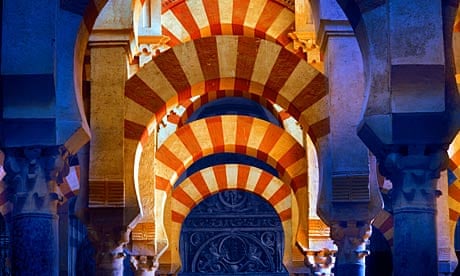A confrontation between Muslim tourists and guards employed by the Roman Catholic bishop at the world-famous Cordoba mosque saw two people arrested and two guards injured last night.
Trouble broke out when the visitors knelt to pray in the building, a former mosque turned into a Christian cathedral in the 13th century, where a local bishop, Demetrio Fernández, recently insisted that a ban on Muslim prayers must remain.
Half a dozen members of a group of more than 100 Muslims from Austria had started praying among the marble columns and coloured arches of the vast building when security guards ordered them to stop.
"They provoked in a pre-planned fashion what was a deplorable episode of violence," the bishop's office said in a statement.
Cathedral authorities said the guards had invited the visitors to continue viewing the inside of a 24,000 sq metre building that was once the world's second biggest mosque, but without praying.
"They replied by attacking the security guards, two of whom suffered serious injuries," the bishop's office said.
Local newspapers reported that a dozen police officers had been called into the building and that these, too, had been attacked when they tried to arrest the two visitors.
The local Diario de Cordoba newspaper quoted anonymous police sources as saying that a knife had been taken off one of those arrested.
A group of local Muslim converts have long campaigned for the right to pray at the mosque building. "The building is very big and the main cathedral occupies only a part of it," said Mansur Escudero of the Junta Islamica group.
"They publicise the building as a mosque because that brings in tourists, but they do not allow the Muslims who pay money to go inside to pray," he said.
Escudero said a space for Muslim prayers would not inconvenience visitors or disturb the cathedral and would promote dialogue and understanding between the two religions. He said there were frequent incidents of Muslims being prevented from praying.
"They argue that canon law does not allow Muslims to pray there, though they have been happy to permit visiting Saudi princes and other dignitaries, including Saddam Hussein, to pray," he said.
"A new bishop was appointed recently and one of his first public statements was to say that Muslim prayers would not be allowed as this would create confusion," he said. "It seems the guards have instructions to prevent prayers with violence, if necessary."
Cathedral authorities reiterated their ban on prayers. "The shared use of the cathedral by Catholics and Muslims would not contribute to the peaceful coexistence of the two beliefs," the statement from the bishop's office said.
"This one-off incident does not represent the genuine attitude of Muslims, many of whom maintain an attitude of respect and dialogue with the Catholic church," it added. "We deplore the damage done to the image of our city and to the peaceful coexistence of visitors and citizens."
Church authorities also recalled that archeologists had shown that, prior to the construction of the mosque in the eighth century, a Christian temple had stood on the same spot.
The 23,400 sq metre mosque occupies an area equivalent to three football pitches and boasts 1,300 columns and more than 300 yellow and red horseshoe arches. There are only three larger mosques in the world – at the holy city of Mecca in Saudi Arabia, the Turkish capital Istanbul, and the Moroccan port city of Casablanca.
Yesterday's incident coincided with the city's famous Easter Week celebrations, where groups of nazarenos (penitents) dressed in long robes and tall conical hats carry statues of Jesus and the Virgin Mary from local churches around the streets.
